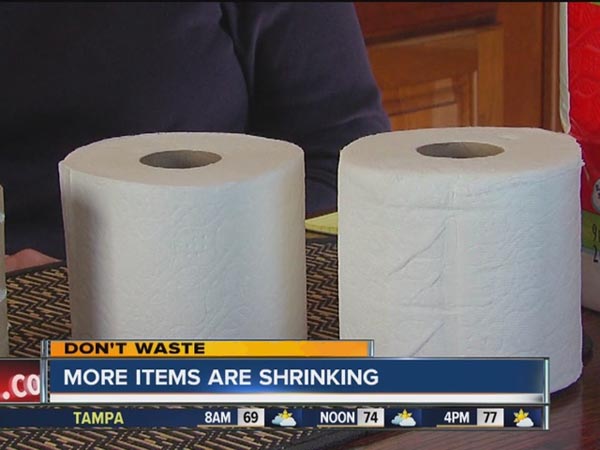Toilet Paper Roll Size in U.S. ‘Steadily Shrinking’
![]() Print this Article | Send to Colleague
Print this Article | Send to Colleague
The Independent, London, U.K, reported this past week that toilet paper squares, the individual sheets that connect to make each roll, were once 4.5 in. wide by 4.5 in. long, consistently, but the standard has shifted, or at the very least, loosened its grip on the industry to a point where companies are now selling sheets up to a half-inch shorter on one side.
According to the article, a reader wrote in to a columnist at the Los Angeles Times recently saying he's noticed "a roughly 26% reduction in the surface area" of his toilet paper.
"The old standard for a single sheet of tissue was 4 and 1/2 by 4 and 1/2 inches, a nice square," he said. "Some tissue companies have changed the length of the sheet to 4 inches, with a width of 4 1/2 inches, no longer a square."
Others, including Consumer Reports, have had their departments take notice and are now attempting to highlight the ‘trend’ as well. The consumer advocacy group said that rolls are becoming "narrower," cardboard tubes are getting "bigger" (although multiple brands have now released tubeless rolls in recent years), and sheets are shrinking in both size and number. So, they say, toilet paper rolls might look the same at a first or even second or third glance, even though they carry less actual toilet paper.
As a result, toilet paper sales may have only slightly increased in recent years, but value per weight has risen significantly and has been a noticeable boost to the industry. In 2013, unit price for tissue rose by 2%, after growing by nearly the same the year prior, according to data from market research firm Euromonitor.
"The practice has been a tried and true strategy for makers of tissue and toilet paper, allowing companies, quietly and effectively, to raise prices per unit," the Wall Street Journal noted in 2013.
But there is more to the story than what is simply good for the industry. Consumers and the environment might be the ones, ironically, benefiting most from this transition over time. Although their observations at the moment are simply that they are getting slightly less volume in their product, they are also getting a newer and more effective product in the soft, strong, and absorbent fiber structures that are rolling off of new machines making the slightly leaner sheets.

Sure, Americans might appreciate soft, strong, and durable toilet paper. But above all, they value affordability. The market for standard toilet paper, which is the least expensive, is easily the industry's largest segment, accounting for well over 60% of all sales. And it's still growing at roughly the same clip — approximately 2% per year — as any other, as the article cites, safeguarding low prices from producers to consumers. So the price of toilet paper rolls, according to a report by NPR this past year, compared with certain foods at grocery stores, have seen much less price inflation in the past few years. The vast majority of consumers are not noticing any alarming price increase at checkout when purchasing tissue products. Only a very slight minority are noting any change in size and texture in these recent consumer reports, and not in product performance, which could be interpreted as a testament to the fact that superior tissue grades available to the public compared with a half century ago are more effective while creating less waste.
In addition to a profit motive natural for companies able to make tissue with the same effectiveness on better and/or smaller, more modern sheets from new tissue mills, there is a motive as it relates to sustainability.
Standard tissue and similar hygiene products from the paper industry cannot enter a chain of recyclability as it is difficult and impossible under most if not all known international regulations. Less toilet paper as a waste product, though biodegradable compared with common waste products such as plastic bottles, is a positive for the environment and for tissue producers’ ratings when it comes to corporate sustainability goals and related accreditation and/or awards. As we move further into this new century and making sustainability a top priority, perhaps it’s time to think "outside the square" when it comes to tissue.


